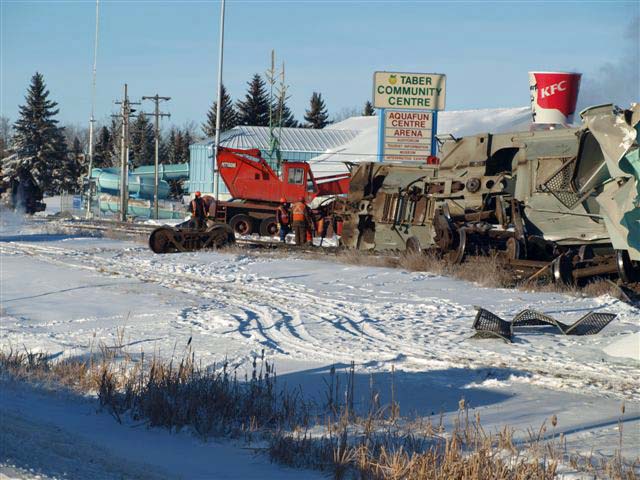|


The Taber train wreck - 2009 Photographer unknown.
18 July 2013
We Dodged the Bullet
Lethbridge Alberta - It could have been so much worse. A Canadian Pacific train jumped the tracks and careened toward a gas station, a
restaurant, and Taber's major recreation facility.
Fortunately, says Mayor Ray Bryant, the derailment happened about 2 a.m. and few people were nearby. Even better, the damaged rail cars spewed potash but not
any hazardous or explosive commodities.
"We dodged the bullet," Bryant says, speaking in the wake of the Lake Megantic disaster in Quebec. "Things could have a been a lot
worse."
As in Lake Megantic, officials said a number of rail cars split open during the Taber crash. If they'd contained hazardous commodities, the crash could have
become a catastrophe.
Bryant points out fuel, chemicals, and other goods far more dangerous than potash continue to be hauled through town every day.
The Taber train wreck came in 2009, but Bryant says the risks are higher now.
"Today we have two to three times as many trains going through," nearly one every hour at some times of day. "And the trains are longer and
heavier."
Town officials have little information on what they're carrying, he adds.
In the aftermath of the Lake Megantic catastrophe, "That does raise our concerns."
"We simply don't know what the CPR is carrying," so emergency responders can't presume they're prepared for all possibilities.
Now he's hoping for a meeting with Canadian Pacific representatives, to update town officials on the list of chemicals and other dangerous goods moving by rail
through Taber.
For Taber, far above any flood plain, the mayor says a CP derailment is considered the town's greatest risk of disaster. When emergency personnel test their
response plans, it's a Canadian Pacific train wreck they simulate.
More than 20 cars of a 117-car train left the tracks, according to emergency officials running a recent simulation, and 11 of them contained dangerous goods.
They included gasoline, diesel fuel, liquid propane, and anhydrous ammonia, potentially deadly at close range.
Bryant stresses Taber residents are far from the only Canadians placed in danger when hazardous goods are hauled through town. Even in some of the nation's
largest cities, like Calgary, the mainline tracks go right through the heart of the community.
"All the towns have been built along the railway," in most parts of the nation.
But some communities have managed to reduce their exposure. In the 1980s, the rail marshalling yards in Lethbridge, Vancouver, and some other cities were moved
away from downtown.
But in Lethbridge, at least, the rail line passes close by two of the city's shopping malls and several of its major industries, as well as seniors'
condominiums downtown, and upscale homes in Heritage Heights.
Some other cities, including Edmonton, have been more pro-active. There, a Canadian National yard and the VIA Rail station were relocated far from the city
centre while the Canadian Pacific line was stopped short of the High Level Bridge.
In Saskatoon, Mayor Don Atkinson says VIA Rail and CN moved to the edge of town but Canadian Pacific still runs freights across some of that city's busiest
roadways. He's appealing to federal officials to get CP to relocate as well.
And in industrial Ontario, the mayor of Sarnia is calling for law changes to give civic officials more authority over rail lines in their
communities.
Mayor Mike Bradley says Canada's railways must be made more accountable to the cities and towns they impact.
"We've seen several derailments over the years where there's been no communication with the community," he says.
"They don't have to come to us unless it's really to their benefit to do so."
Dave Mabell.



Vancouver Island
British Columbia
Canada
|